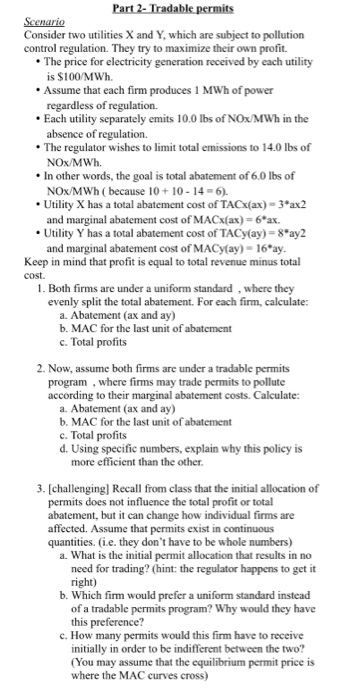a somewhat detailed explanation would be very much appreciated

Part 2. Tradable permits Scenario Consider two utilities X and Y, which are subject to pollution control regulation. They try to maximize their own profit. The price for electricity generation received by each utility is $100/MWh. Assume that each firm produces 1 MWh of power regardless of regulation. Each utility separately emits 10.0 lbs of NOx/MWh in the absence of regulation. The regulator wishes to limit total emissions to 14.0 lbs of NOx/MWh. In other words, the goal is total abatement of 6.0 lbs of NOx/MWh (because 10+ 10 - 14 =6). Utility X has a total abatement cost of TACx(ax) - 3*ax2 and marginal abatement cost of MACx(x) = 6*ax. Utility Y has a total abatement cost of TACy(ay)=8ay2 and marginal abatement cost of MACy(ay) - 16"ay. Keep in mind that profit is equal to total revenue minus total cost. 1. Both firms are under a uniform standard, where they evenly split the total abatement. For each firm, calculate: a. Abatement (ax and ay) b. MAC for the last unit of abatement c. Total profits 2. Now, assume both firms are under a tradable permits program, where firms may trade permits to pollute according to their marginal abatement costs. Calculate: a. Abatement (ax and ay) b. MAC for the last unit of abatement c. Total profits d. Using specific numbers, explain why this policy is more efficient than the other. 3. [challenging) Recall from class that the initial allocation of permits does not influence the total profit or total abatement, but it can change how individual firms are affected. Assume that permits exist in continuous quantities. (i.e. they don't have to be whole numbers) a. What is the initial permit allocation that results in no need for trading? (hint: the regulator happens to get it right) b. Which firm would prefer a uniform standard instead of a tradable permits program? Why would they have this preference? c. How many permits would this firm have to receive initially in order to be indifferent between the two? (You may assume that the equilibrium permit price is where the MAC curves cross) Part 2. Tradable permits Scenario Consider two utilities X and Y, which are subject to pollution control regulation. They try to maximize their own profit. The price for electricity generation received by each utility is $100/MWh. Assume that each firm produces 1 MWh of power regardless of regulation. Each utility separately emits 10.0 lbs of NOx/MWh in the absence of regulation. The regulator wishes to limit total emissions to 14.0 lbs of NOx/MWh. In other words, the goal is total abatement of 6.0 lbs of NOx/MWh (because 10+ 10 - 14 =6). Utility X has a total abatement cost of TACx(ax) - 3*ax2 and marginal abatement cost of MACx(x) = 6*ax. Utility Y has a total abatement cost of TACy(ay)=8ay2 and marginal abatement cost of MACy(ay) - 16"ay. Keep in mind that profit is equal to total revenue minus total cost. 1. Both firms are under a uniform standard, where they evenly split the total abatement. For each firm, calculate: a. Abatement (ax and ay) b. MAC for the last unit of abatement c. Total profits 2. Now, assume both firms are under a tradable permits program, where firms may trade permits to pollute according to their marginal abatement costs. Calculate: a. Abatement (ax and ay) b. MAC for the last unit of abatement c. Total profits d. Using specific numbers, explain why this policy is more efficient than the other. 3. [challenging) Recall from class that the initial allocation of permits does not influence the total profit or total abatement, but it can change how individual firms are affected. Assume that permits exist in continuous quantities. (i.e. they don't have to be whole numbers) a. What is the initial permit allocation that results in no need for trading? (hint: the regulator happens to get it right) b. Which firm would prefer a uniform standard instead of a tradable permits program? Why would they have this preference? c. How many permits would this firm have to receive initially in order to be indifferent between the two? (You may assume that the equilibrium permit price is where the MAC curves cross)








